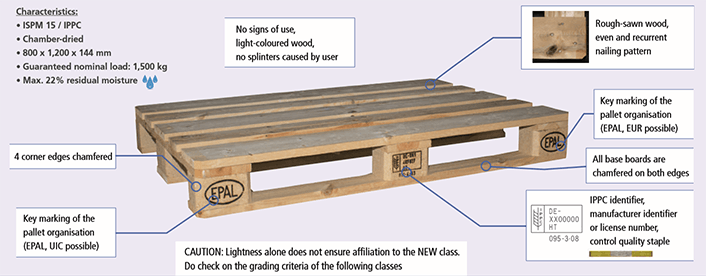Pallets are one of the best-known packaging solutions nowadays, and are mostly used for storage, handling and transport (freight, rail, road or water). They can be made of either wood (the most common approach), metal or plastic – each tpye comes with both advantages and disadvantages. Pallets may differ in sizes, depending on the merchandise placed on them, or on its dedicated purpose. The most common dimensions of a standard pallet are 1200 × 800 or 1200 × 1000 or 800 × 600 (mm).
WOODEN PALLETS – SIZES AND WOOD TYPES
1. Standard: Euro Pallets – EPAL licensed pallets
Euro Pallets (EPAL or EUR pallets) are the most popular and best-known pallet types. They can be produced in different sizes (most common: 1200 x 800 x 144 mm), and they are made of softwood (pine, spruce, poplar). Their side panels are marked with the EPAL logo, and the central block is stamped with the manufacturer’s identification data (verification key). The below picture explains all elements, characteristics and official marks of an EPAL pallet.

2. Non-standard: Non-Euro Pallets
Non-standardized pallets can differ in sizes, depending on load specifications. They can be made of softwood (pine, spruce, poplar etc.), and also hardwood (eg. beech). The most common dimensions for pallets are 1200 × 800 (mm).
The atypical (non-standard) pallets can have either four open sides; two closed and two open sides; or four closed sides – the latter option offers the possibility of handling the pallet over the edges.
Do you have any questions about pallets and their practical use? Contact us at info@palletbiz.com!